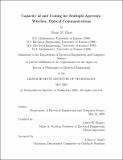| dc.contributor.author | Haas, Shane M. | |
| dc.date.accessioned | 2006-02-22T14:20:17Z | |
| dc.date.available | 2006-02-22T14:20:17Z | |
| dc.date.issued | 2006-02-22T14:20:17Z | |
| dc.identifier.uri | http://hdl.handle.net/1721.1/31213 | |
| dc.description | Thesis Supervisor: Jeffrey H. Shapiro
Title: Julius A. Stratton Professor of Electrical Engineering | en |
| dc.description.abstract | Refractive index turbulence causes random power fluctuations in optical communication systems, making communication through the atmosphere diffcult. This same
phenomenon makes the stars twinkle at night, and pavement shimmer on a hot sum-
mer day. True to the old adage, "don't put all your eggs in one basket," we examine
laser communication systems that use multiple transmit and receive apertures. These apertures provide redundant replicas of the transmitted message to the receiver, each corrupted separately by the atmosphere. Reliable communication occurs when not all of these paths are deeply faded. We quantify the maximum rate of reliable communication, or capacity, and study space-time coding techniques for both direct- and coherent-detection receivers. We also experimentally verify the performance of some simple techniques for optically-preamplified, direct-detection receivers. | en |
| dc.description.sponsorship | Defense Advanced Research Projects Agency | en |
| dc.format.extent | 3006356 bytes | |
| dc.format.mimetype | application/pdf | |
| dc.language.iso | en | en |
| dc.relation.ispartofseries | Technical Report (Massachusetts Institute of Technology, Research Laboratory of Electronics) | en |
| dc.relation.ispartofseries | 665 | en |
| dc.title | Capacity of and Coding for Multiple-Aperture, Wireless, Optical Communications | en |
| dc.type | Technical Report | en |
